Intro
Shortly after the death of Charlemagne, three major events marked the Carolingian Empire:
- Succession troubles lead to the break-up of the Empire, from now on the Germanic part is definitively separated from the Romanesque part. These are the first faces of France and Germany that appear.
- Europe is plagued by new invasions (Saracen, Hungarians, Normans...). The Vikings, however, pose the most significant threat. Their intrusion into "Francia" will change the country forever.
- The Robertiens (from Robert le Fort, ancestor of the Capétiens) will very quickly impose themselves against the reigning Carolingians. For a century, the two families will dispute the crown before it is definitively attributed to the Robertians.
The division of the Empire
The death of the Emperor
It was as the last surviving son of Charlemagne that Louis I the Pious (or the Débonnaire) obtained the title of Emperor of the West in 814. The empire would therefore not be divided, as it was customary to do in the time. For some time yet, the machine created by Charlemagne will continue to function. But Louis I, who called himself "le Débonnaire" because of his weakness of character, was not the man capable of maintaining unity. Until his death, he will fight against his first three sons (Pépin, Louis, Lothaire), jealous of their half-brother, Charles, son of his second wife Judith of Bavaria. Moreover, Pope Stephen IV gains independence and the link between Rome and the Empire seems to be broken. After the birth of Charles, a new partition is decided, this one does not please the three brothers who depose their father in 833. Pépin and Louis, regretting having given all the powers to Lothaire (the eldest who had obtained the largest share of power), restore their deposed father in 835. In 840, Louis the Pious dies, leaving behind him a succession that promises to be delicate.
The three brothers
Pépin d'Aquitaine, second son of the emperor died in 838. On the death of Louis le Débonnaire, the Empire was therefore divided between his three other sons:Louis le Germanique, Lothaire and their young half-brother Charles le Chauve. Only, Lothair decides to appropriate the entire territory. Louis therefore allied himself with Charles against their eldest who was defeated in 841 (battle of Fontenoy en Puisaye). The two brothers take an oath in Strasbourg (842), then reach Aix-la-Chapelle, where Lothaire is forced to accept a fair share. In 843, the partition was finally decided in Verdun:
- Lothaire receives central Francia, from the North Sea to Italy, he retains the title of emperor.
- Louis the German receives East Francia or Germania (the future Germany).
- Charles the Bald receives West Francia (the future France).
The brothers then try to pursue a more fraternal policy, by trying to consult each other. Alongside his fratricidal quarrels, the first Norman skirmishes appeared on the Channel and Atlantic coasts.
The division of Verdun

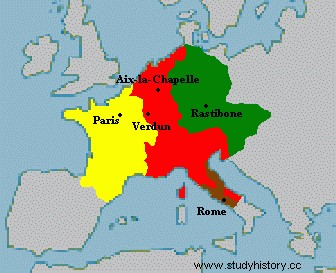
The Normans
The first Norman incursions
In 793, the Vikings (warriors of the Sea) made their first incursion on an English island, plundering and ransacking a monastery. Their reputation even reached the court of Charlemagne, arousing terror. It must be said that they do not do things by halves, arriving on their prey by surprise, mutilating them from all sides, and setting fire to everything in their path. Reputed to be invincible, these barbarian warriors belong to a very ancient civilization. They were from Scandinavian countries (Denmark, Finland, Norway). Their villages were located at the bottom of the fjords, where meager land allowed cultivation and animal husbandry. It was probably the overpopulation and the inability of these infertile lands to feed all their inhabitants that pushed the clans to seek their fortune elsewhere. Later when they realized that the borders of the Carolingian empire were no longer protected, it was the population of entire regions that took part in military expeditions, thus changing the destiny of several countries. Their expansion was in two directions:
- Towards the east and the plains of Russia (Varangians originating from Sweden).
- Westward, where they conquered the northern islands, from England to Greenland (conquest of Erik the Red), then descended southward, reaching Sicily (Robert Guiscard) and Constantinople! Leif Erikson, son of Erik the Red even reached North America.
The drakkar, terror of the seas
Tireless navigators, whose maritime technique was superior to all other peoples of the time, the Normans used the knorr. Low on the water, streamlined, flexible, it was nicknamed "the steed of the waves", but those who saw it appear on the horizon called it the drakkar, that is to say dragon, because its prow was often surmounted by a head of this fantastic animal.
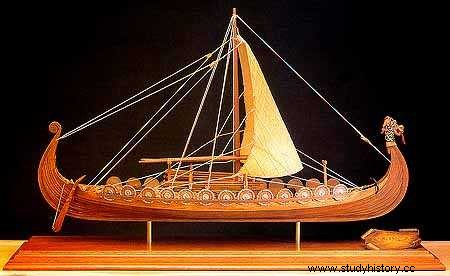
The Viking Society
The Vikings lived in small villages, houses and farms were usually made of wood, with a roof covered with straw. Viking society was divided into groups. A chief, or king, commanded the clan in times of war. But, ordinarily, the important decisions were made by the thing , or assemblies of free men. From 930 were convened assemblies of the entire Viking nation, called al thing . Free men were divided into karl , wealthy farmers who formed the bulk of the army, and in jarl , modest farmers who had to work their fields themselves. At the bottom of society, the slaves, or thrall , prisoners or Vikings reduced to servitude because they had not been able to pay their debts. The Vikings shared the religion of the Germans, the Norse religion. After the more or less forced conversion of all of Germany by Charlemagne, they remain the only worshipers of Thor and Odin. But little by little, the whole Viking world is converted. In the year 1000, Iceland became Catholic by political choice.
Scandinavian Mythology
Norse mythology is made up of the legends originating from the religion once practiced in much of northern Europe. A pantheistic religion granting a large place to Nature, to women (several important goddesses) and to divination (art associated with runes), it places Life at the center of its system, a life conceived as a confrontation between the forces of creation and dissolution, whence results all fecundity. Beyond the Gods, mythology also evokes the presence of famous creatures (trolls, elves, giants, dragons...).
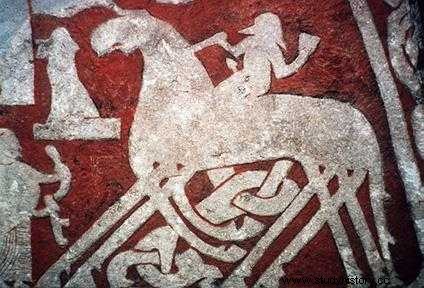
The advent of the Robertians
The reign of Charles the Bald
When Charles the Bald receives West Francia, some regions refuse his guardianship. This is the case of Brittany where Nominoë managed to keep his kingdom by defeating the royal troops (846). The Aquitaine, meanwhile, proclaim King Pepin II, son of their previous king Pepin I (also half-brother of Charles). But in 841, the Normans made their first incursion on the French coasts by ransacking Rouen, looting everything in their path. Very quickly the kingdom is invested, and the Aquitanians are forced to deal with Charles the Bald, then end up offering him the kingdom of Aquitaine. Pepin II, vexed, will join forces with the Vikings to sack his former kingdom. Each year, the Vikings return, even more violent, Charles does not manage to find the support of the other Nations of the treaty of Verdun, he tries in vain to restore the situation but at the price of heavy concessions. As early as 856, the Vikings made their first major incursion, this wave of surges only ceased in 861. Given the gravity of the situation, Charles was forced to entrust military responsibilities to senior leaders.
Robert the Strong, father of the Robertians
At the same time when Charles the Bald reigned, an important figure in the History of France appeared, it was Robert the Strong. Belonging to the same family as the first wife of Louis the Pious, Robert became missi dominici in 853. Two years later, he rose up against his king, then became duke of the region between the Seine and the Loire. He then distinguished himself against the Bretons, but above all he stopped the Normans twice (864 and 865). Robert then becomes one of the most influential people in the kingdom. In 856, the situation became more serious, Charles the Bald then entrusted him with an important command in the West. Robert fortifies cities and rivers and vigorously confronts the Normans. The same year, he died during the battle of Brissarthe near Angers. During this time, Charles tries to subdue the conflicts with the French aristocracy. On the death of Emperor Lothair, Louis the Germanic (Germany) and Charles the Bald (France) decide to share the kingdom of their deceased brother. In 875, Charles's friendships with the papacy were favorable to him, he managed to win the title of emperor. But, he died in 877, leaving behind him a difficult situation in the kingdom.
The Vikings landing on the French coast
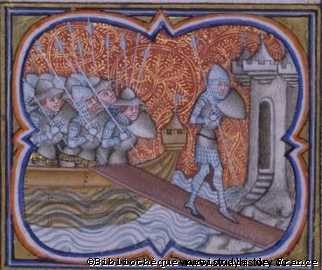
(National Library of France)
Strengthening the Robertians
After the death of Robert le Fort, his half-brother Hugues l'Abbé was entrusted with the guardianship of his two sons:young Eudes and Robert. Hugues fulfills his role very well by reinforcing the legacy of Robert the Strong. He fortified the strongholds of the Center region (Orléans, Blois...), but above all he gained influence at Court. Thus, on the death of Charles the Bald, the king's son, Louis II le Bègue, was subject to the great influence of the Greats of the kingdom who elected him king at the cost of heavy concessions, Louis was even forced to accept the guardianship of 'Hugues l'Abbé who acts as the mayors of the palace did under the Merovingians. Louis le Bègue is weak and sick, under his reign, the royal power loses its authority. He died prematurely in 879. From then on, it was the parties of the Great who held the crown in their hands, however the supporters of the legitimate kings prevailed and the crown was then granted to Louis III and Carloman, the king's two sons. With the disputes experienced by the kingdom, the country had been at the mercy of the Normans for several years. The latter have since changed their method, instead of just going up the rivers, they are engulfed more and more inland. The two young kings are more active than their father, and it is the eldest Louis who is responsible for fighting against the Normans. After several successes, Louis falls ill and dies, his 16-year-old brother Carloman tries to take over his brother's work. But the Great then decide to pay a large tribute to the Vikings in exchange for their withdrawal. Carloman died in 884 during a hunting accident.
The Robertians
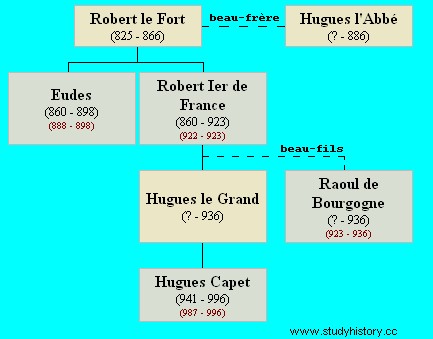
The Robertians on the throne
Faced with internal anarchy and the threat from Normandy, the Greats dismissed the last son of Louis le Bègue (aged 5), and entrusted the crown to Charles le Gros, son of Louis le Germanique, who, already possessing the heritage of his father, then becomes Emperor of the West. The unity of the empire is then reunited, but Charles the Fat is far from having the stature of Charlemagne. Affected by epilepsy, the sovereign proves mediocre and incapable of assuming such a title. Eudes, the son of Robert le Fort, was then named Count of Paris. Faced with the immobility of the emperor, the Normans began the assault on Paris during the winter of 885-886. But the city does not give in, Count Eudes covers himself with glory by courageously defending his territory. It is a decisive success which is worth to Eudes the support of the Large ones of the kingdom. Thus in 888, Charles le Gros was overthrown, and Eudes became king of France. Ancestor of the Capétiens, he wears the crown 108 years before Hugues Capet. This is the culmination of the seizure of power by the Nobility. The Frankish hereditary monarchy became elective. The king who appointed the dukes and counts (officials of the kingdom) is now chosen by them and among them. Eudes continues the work of his father Robert le Fort, and defeats the Normans at Montfaucon. The second wave of Norman invasion which began in 879 seems to end in 892. To avoid internal dissolutions, Eudes made the Carolingian Charles III his successor to the crown.
Eudes, defending Paris from the Normans
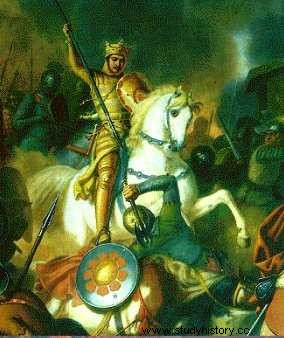
The settlement of the Vikings
On the death of Eudes in 898, it was Charles III the Simple who, as agreed, ascended the throne. But the royal power has changed a lot. To respond to the Norman, but also Hungarian and Saracen invasions, the king recognized and shared his power with the counts and marquises of the kingdom. The king's field of action is then narrowed. But the new system of power transferred to the princes bears fruit. Thus, the action against the Normans is more local and precise, and it ends up paying off. Rollon, one of the Norman leaders, fails in front of Chartres thanks to the alliance of the aristocracy of the North of France. From both parties, we are then ready for a common agreement. In 911, by the treaty of Saint-Clair-sur-Epte, passed between Rollo and Charles III, Normandy (land of the Normans) became a duchy given to the Normans (men of the North), against the promise to cease the raids on the Seine, to be baptized, to marry Gisèle de France, the first daughter of Charles the Simple. The settlement of the Vikings thus put an end to the Norman invasions, and their leader Rollo then found himself a vassal of the King of France.
The Baptism of Rollo
In exchange for the territory of Normandy, Rollo must convert. He was baptized under the name of Robert in Rouen.
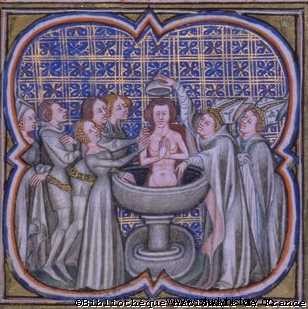
(National Library of France)
Cohabitation:Robertians and Carolingians
Charles the Simple faced with the revolt of the Robertians
The end of the Norman problem then leads the lords of the kingdom to rise again against the king. Robert, brother of Eudes had always supported his brother during his reign. On the death of Eudes, Robert receives the inheritance of the family (march of Neustria, counties of Paris, Blois, Orléans...). This powerful marquis is in charge of defending the West against the Bretons and the Normans. He continued this work under Charles the Simple, notably defending the city of Chartres against Rollo. In 911, when peace was made with the Normans, Robert allied himself with the other feudal dynasties, he found the support of his son-in-law Raoul of Burgundy. During this time, Charles is opposed to the families of the East to claim Lotharingie which he ends up obtaining. In 920, during an assembly, Charles fell out violently with Robert. In 922, the Robertians then fomented a revolt against the king and succeeded in electing Robert, king of the Franks. Charles the Simple is forced to flee, but he has enough supporters in Lotharingia to counterattack. During the Battle of Soissons, Robert is killed in battle, but his son Hugh the Great, galvanizes his soldiers by showing his father's corpse, and ultimately the battle will be lost by the Carolingian heir. The great feudatories still refuse to recognize him as king and prefer Raoul de Bourgogne (step son of Robert). Charles, who had become an uncrowned king, found refuge with his vassal, Herbert II de Vermandois, who held him prisoner (Robert I was his brother-in-law), and locked him in a tower of the Château de Péronne where he died in 929 after 6 years of captivity.
The reign of Raoul of Burgundy
The accession of Raoul de Bourgogne led to the loss of Lotharingia in favor of the King of Germany, Henri l'Oiseleur. Raoul then devotes himself to the fight against several Norman troops not implemented in Normandy. He is forced to buy their withdrawal. Political life in the West sees the rivalry between Raoul and Herbert de Vermandois who wants to enlarge his county. Soon Herbert uses means of force:rapprochement with Germany, appeal to the Normans of Rollo, blackmail for the restoration of Charles the Simple (Herbert holds Charles prisoner in his stronghold). Hugues le Grand, son of Robert then made an alliance with Raoul to fight Herbert's claims. The intervention of the Saxon king Henry I saves the rebel. In 935, the two parties signed peace. Raoul then concentrates on extending his influence against the great lords. But his action is in vain, he cannot prevent the division of the kingdom into large principalities, the result of feudalism and the growing power of his vassals. The king not having fiscal resources and therefore an army was forced to form an alliance with the dominant dynasties of the kingdom. Raoul died in Auxerre in 936.
Assassination of Guillaume Longsword
Son of Rollo, Guillaume Longue-Epée took the oath to the new king of France, Raoul de Bourgogne. He is one of the founders of the Duchy of Normandy. He married the daughter of Herbert, Count of Vermandois. Guillaume nicknamed "Long Sword" is energetic and influential, he made several alliances with Hugh the Great. Lured into an ambush, he was assassinated by the Flemish at Picquigny in the Somme.
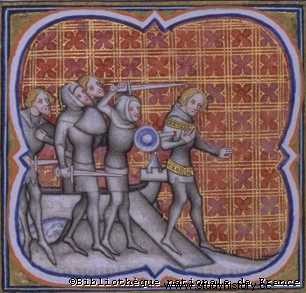
(National Library of France)
The Carolingian Restoration
On the death of Raoul, Hugh the Great, son of Robert of France, appears as the most powerful character in the kingdom. It has many counties and several abbeys. He does not wish to govern himself because he does not want to give up his counties. He then decided to give the crown to the son of Charles the Simple:Louis IV d'Outremer, so nicknamed because he was raised at the court of Wessex in England. Aged 16, Louis arrives in Boulogne and is only an instrument in the hands of Hugues. The latter uses Carolingian legitimacy to bring down his competitor Herbert de Vermandois. Louis emancipated himself very quickly and soon became Hugues' main rival. After several diplomatic dodges, the king manages to gather an army to attack Duke Hugh. Only, he only owns the region of Laon, he has no authority over all the regions south of the Loire. It was Hugh the Great who reigned over France and Burgundy. The king is therefore captured by the Normans and delivered to Hugh. Released a year later, after ceding the stronghold of Laon, Louis IV made an alliance with his brother-in-law Otto I (Emperor of Germany) who did not accept the lowering of royal power. The Ottonian army enters France but is unable to take a stronghold such as Laon or Paris. Hugues indeed controls most of the territory of the kingdom. But the sovereign manages to subdue him, who is soon forced to bow under pain of exclusion from the Church. Eventually, Louis died soon after from a fall from a horse in 954. And with the consent of Hugh the Great, Louis's son Lothair ascended the throne. The death of Hugh in 956 will favor the beginning of his reign. But the prudent diplomacy of the heir to the Robertians, which allowed him to considerably enlarge his domain, under penalty of twice refusing the throne, will allow the advent of his son:Hugues Capet. The Capetian dynasty will thus remain on the throne for nearly 900 years.
